| Author |
Message |
|
Rich Knack
|
 Posted: Thu 09 Jan, 2014 7:31 pm Post subject: messer suspensions? Posted: Thu 09 Jan, 2014 7:31 pm Post subject: messer suspensions? |
 |
|
Scott Woodruff is currently working on a one-handed messer (~21" blade) with a by-knife and pricker for me. More than likely, it will be coming with a lined scabbard core which I will be covering myself (including sheaths on the outside for the by-knife and pricker).
What I am wondering is, what suspension methods were used for messer scabbards in the late 15th-early 16th centuries? Are there any surviving examples?
"Those who 'beat their swords into plows', will plow for those who don't."
|
|
  |
 |
|
Radovan Geist
|
|
  |
 |
|
Rich Knack
|
 Posted: Fri 10 Jan, 2014 7:45 am Post subject: Posted: Fri 10 Jan, 2014 7:45 am Post subject: |
 |
|
How would the pockets for by-knives and prickers have been formed?
"Those who 'beat their swords into plows', will plow for those who don't."
|
|
  |
 |
|
Adam Bodorics
Industry Professional
|
 Posted: Sat 11 Jan, 2014 5:33 am Post subject: Posted: Sat 11 Jan, 2014 5:33 am Post subject: |
 |
|
|
The easiest and IMO quickest way is to make the wooden core first, then the mini-sheaths, then cut the leather cover for the wooden core with some allowance, cut a slit into it where you want the accessories to protrude, wet the leather cover, push the mini sheaths with the accessories into the slit, and wrap it around the wooden core, secure with either glue (I prefer gelatin, cheap and easy to get), or hold the leather in place with clamps, and sew it. My quickie version, with enough patience you can make it much more pretty.
|
|
  |
 |
|
Rich Knack
|
 Posted: Sat 11 Jan, 2014 6:45 am Post subject: Posted: Sat 11 Jan, 2014 6:45 am Post subject: |
 |
|
Thanks! How did you make the chape for that scabbard, anyway? For that matter, is a chape (or locket) even necessary to be "period correct"?
By the way, the page at http://www.imareal.oeaw.ac.at/realonline/ does not seem to be 100% functional any more, so that isn't much of a help, unfortunately, in looking at period scabbards and suspensions.
"Those who 'beat their swords into plows', will plow for those who don't."
|
|
  |
 |
|
Adam Bodorics
Industry Professional
|
 Posted: Sat 11 Jan, 2014 10:41 am Post subject: Posted: Sat 11 Jan, 2014 10:41 am Post subject: |
 |
|
Try the new address at http://tethys.imareal.sbg.ac.at/realonline/.
Those brass accessories are made from 1mm thick brass plate with a hammer on an anvil (edit: sorry for being so vague, but I can't really word it differently. I just hammer it until it either gets trashed, or looks acceptable or, sometimes, good). You could use thinner plate, it's just that I have 1mm thick in stock.
It's not absolutely necessary, but I was running low on leather, so the wooden core is not covered fully, which had to be concealed.
|
|
  |
 |
Craig Peters

|
 Posted: Fri 24 Jan, 2014 11:39 pm Post subject: Posted: Fri 24 Jan, 2014 11:39 pm Post subject: |
 |
|
Richard,
Here's one from circa 1450, Germany.
 Attachment: 66.75 KB Attachment: 66.75 KB
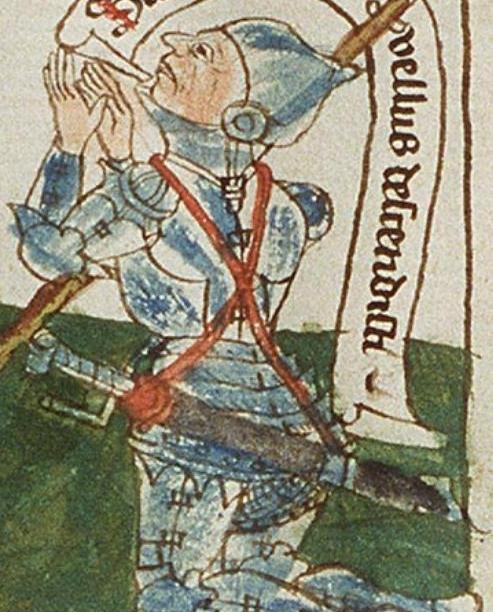
|
|
  |
 |
Craig Peters

|
 Posted: Fri 24 Jan, 2014 11:44 pm Post subject: Posted: Fri 24 Jan, 2014 11:44 pm Post subject: |
 |
|
Another one, from the same manuscript:
 Attachment: 70.49 KB Attachment: 70.49 KB
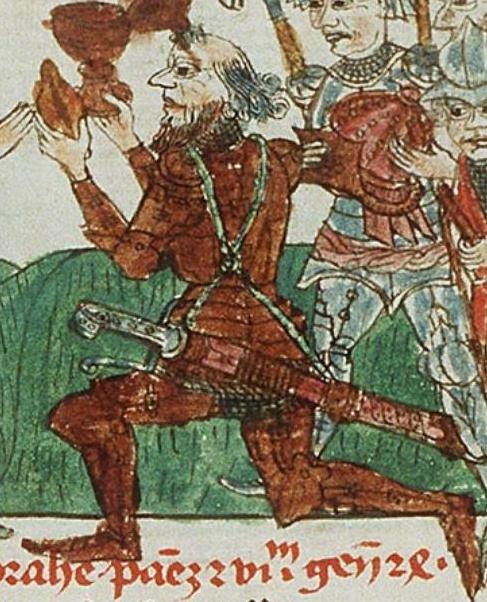
|
|
  |
 |
Craig Peters

|
 Posted: Fri 24 Jan, 2014 11:51 pm Post subject: Posted: Fri 24 Jan, 2014 11:51 pm Post subject: |
 |
|
Since I see no pommel on this sword, I am going to assume it's a grossemesser. If it's not, then we have a good example of a falchion scabbard and suspension:
 Attachment: 21.59 KB Attachment: 21.59 KB
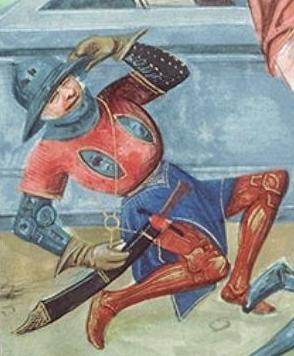
|
|
  |
 |
Craig Peters

|
 Posted: Sat 25 Jan, 2014 12:08 am Post subject: Posted: Sat 25 Jan, 2014 12:08 am Post subject: |
 |
|
The tags on this page call this weapon a falchion, but the hilt is pure messer:
 Attachment: 23.63 KB Attachment: 23.63 KB
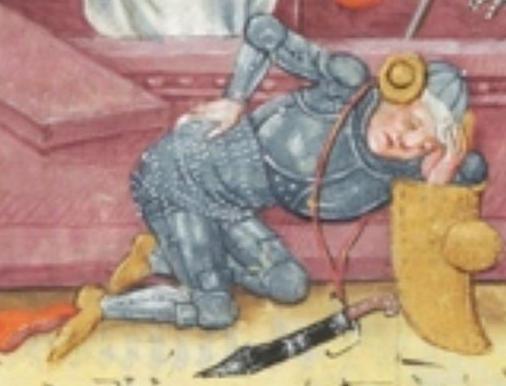
|
|
  |
 |
Craig Peters

|
 Posted: Sat 25 Jan, 2014 12:22 am Post subject: Posted: Sat 25 Jan, 2014 12:22 am Post subject: |
 |
|
Helpfully, the judge of the duel between Luithold von Konigsegg and his opponent wears a grossemesser with a scabbard and suspension in Talhoffer's 1459 edition fechtbuch. I say "helpfully" because it is the only time a scabbard and suspension are shown for a grossemesser in the entire manuscript.
 Attachment: 27.97 KB Attachment: 27.97 KB
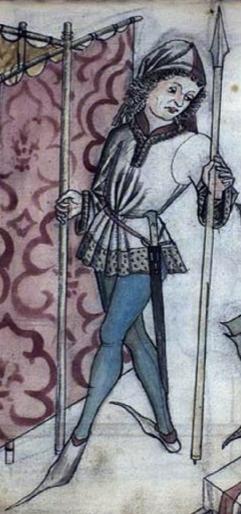
|
|
  |
 |
|
Rich Knack
|
 Posted: Sat 25 Jan, 2014 6:10 am Post subject: Posted: Sat 25 Jan, 2014 6:10 am Post subject: |
 |
|
Looks like four of those are a sort of baldric. I wonder if that is because the wearers are in armor, and a regular sword belt wouldn't work as well? Or if that was just a popular way of carrying them at the time?
"Those who 'beat their swords into plows', will plow for those who don't."
|
|
  |
 |
Craig Peters

|
 Posted: Sat 25 Jan, 2014 4:27 pm Post subject: Posted: Sat 25 Jan, 2014 4:27 pm Post subject: |
 |
|
|
I have not seen this previously looking at grossemessers worn with civilian dress, so I think it's for amour. My hypothesis is that it might be to prevent the faulds from damaging the straps. However, having not spent much time looking at plate armour in art, it could well be that other swords are represented hanging from a belt at the waist, and that my hypothesis is incorrect.
|
|
  |
 |
Craig Peters

|
 Posted: Sun 16 Mar, 2014 9:24 pm Post subject: Posted: Sun 16 Mar, 2014 9:24 pm Post subject: |
 |
|
I wanted to indicate some of my findings on messer scabbards and suspensions from period art in case others are interested in having them made.
As far as scabbards go, the most common colour by far seems to have been black, with dark brown scabbards also being seen. Rarely, the scabbards will have incised lines in a pattern like a diamond lattice work and a riser, but the great majority do not. Not all scabbards will have a chape; a good proportion of 15th century scabbards do not. Moving into the 16th century, it seems that messer scabbards without a chape are primarily associated with lower class individuals. See, for example, the 1521 German woodcut print by Hans Weiditz held at the British Museum, 1845.0809.1693.
For messer suspensions, there seem to be two main types. Suspensions made for civilian wear are virtually always supported by a belt around the hips and hang with the messer lying vertically down. For military wear, i.e. worn with a harness, messers tend to be supported by one or two shoulder straps (see my images above) and hang with the messer at the hips, with the point angled down towards the ground. In the 16th century, we sometimes see civilians wearing messers attached to a belt at the hips with the messer angled down (see the woodcut mentioned above); however, for 15th century civilian wear, the messer and scabbard should hang vertically. There may be exceptions to this pattern of 15th century civilian suspensions that I am not aware of, but the great majority are shown with the messer lying vertically, so this is the style that best represents an authentic period look.
|
|
  |
 |
Mark T

|
 Posted: Fri 25 Jul, 2014 2:47 am Post subject: Posted: Fri 25 Jul, 2014 2:47 am Post subject: |
 |
|
While this image is of a sabre, I thought I'd post it here as it's one of the few we have showing suspension of rings from belt hooks this clearly.
Sourced from Imareal:
| Quote: | | Pfeilmartyrium des Hl. Sebastian, Flügelaltar, Niederösterreich, c.1490-1500 |
And to think I'm meant to be finding images of Armbrüste!
 Attachment: 203.53 KB Attachment: 203.53 KB
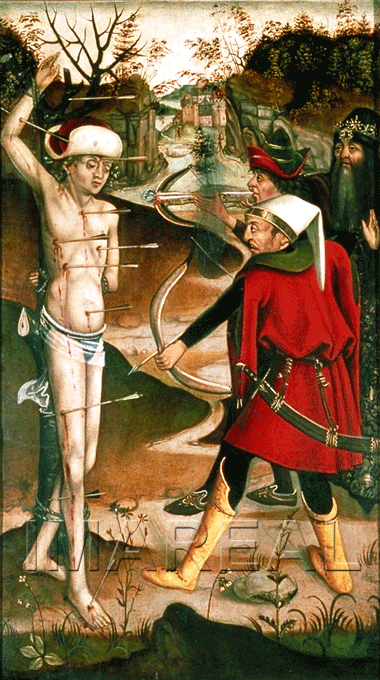
 Attachment: 245.1 KB Attachment: 245.1 KB
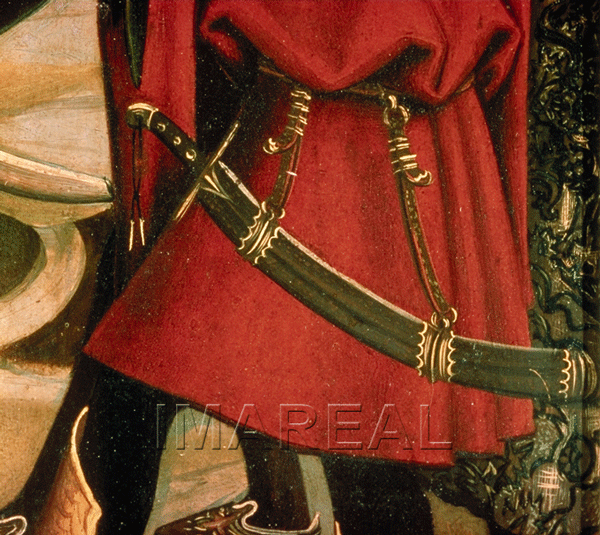
Chief Librarian/Curator, Isaac Leibowitz Librarmoury
Schallern sind sehr sexy!
|
|
  |
 |
|
|

